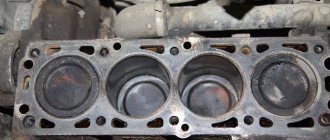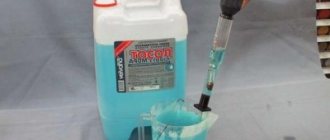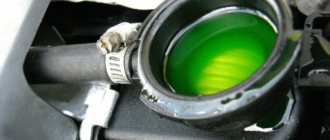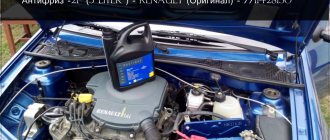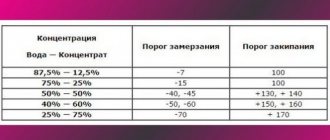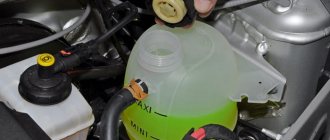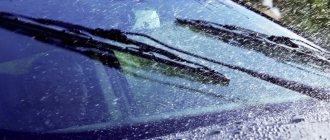Literally half a century ago, car owners had no problems choosing antifreeze. Ordinary water was poured into the radiator, which was drained at night when frost set in.
Modern power plants place higher demands on coolant; simple tap water is no longer sufficient.
In addition, with the frantic pace of life, it is impossible to imagine a car owner who drains water from the engine every winter evening and fills the radiator again in the morning.
Constantly changing environmental and technological requirements have led to the fact that instead of plain water, drivers use a variety of coolants: antifreeze, antifreeze G11, G12, G13, as well as their subclasses. And the main problem of this diversity is the incompatibility of the compositions.
Kinds
Antifreeze Vag G13
A technical mixture that protects the car engine from crystallization, corrosion processes and temperature surges at the same time.
Applicable at any time of the year, goes well with aluminum engines. The additives that are included in the structural composition of the Vag G13 technical solution are not aggressive towards the rubber components included in the cooling system of the machine.
Vag G13 antifreeze has the following characteristics:
- Protects against freezing. If the concentrate is diluted correctly, the temperature range will vary from 25 to 40 degrees below zero.
- Fireproof. The boiling point is at 135 degrees.
- Prevents precipitation;
- Eco-friendly.
Motul inugel G13
Motul Inugel G13 coolers are produced as a concentrate, which must be diluted with water. Typically purified or distilled. The base of the solution is dihydric alcohol ethylene glycol and glycerin with a large number of additives of organic and inorganic origin.
During the production process, a special “Lobrid” scheme is used, which provides maximum permissible protection for the cooling system mechanisms and extends their service life.
According to the manufacturer, the composition is recommended for use in the affordable Vag automobile line. The technical mixture perfectly protects polymer and metal surfaces in the engine from temperature fluctuations, hardening, lime, rust and increases the service life of the water pump.
Motul Inugel
This is a concentrate that cannot be used in its pure form. It is used only after dilution. The main component is monoethylene glycol. Glycerin, organic and inorganic additives and heat are added to it.
The special technology used to make the product protects car parts and increases their service life. Coolant is especially effective against the formation of scale and corrosion on objects made of aluminum and metal. She is not afraid of freezing and overheating. A water pump with such liquid will last longer.
What colors of antifreeze can be mixed with each other?
What factors does color depend on?
Due to its composition, antifreeze does not have the ability to freeze at low temperatures. It is added to the extensive tank of the cooling system of automobile transport in order to reduce the temperature of the operating mechanisms of the engine and protect them from overheating.
Any antifreeze is a chemical compound (ethylene glycol), which consists of glycols, purified water and additional additives. In its natural form, it poses a threat, since the concentrate adversely affects the resistance of engine components to corrosion processes. To avoid this, various silicates are added to the composition to reduce the effect of corrosion on the elements. It may differ according to established standards containing certain norms. These standards distinguish coolants from each other by introducing a package of additives into the solution.
The color of antifreeze is formed by introducing harmless pigments into the technical liquid. The standards do not provide for a definition of color, but there is mention of some rules:
- Only saturated colors are applicable;
- The actual color of the antifreeze can be any, the main thing is that the technical solution differs from gasoline and purified water.
These recommendations were created for a specific purpose: if coolant leaks from the cooling system tank, it will be easier for the car owner to determine that it is the coolant that is leaking due to the brightness of the color.
Antifreeze for Hyundai and Kia
Is antifreeze mixture acceptable?
So, the color depends only on the dye introduced into the solution, and this can lead to the erroneous conclusion that all refrigerants are the same. But this is not so, antifreezes differ from each other in other parameters. For example, the composition of the functional additive package is divided into four types:
- Traditional compositions: mostly no longer relevant, but are occasionally used when cars are first filled at manufacturing plants.
- G11: Mixed, including inhibitors of organic and inorganic nature.
- G12 and G12+: carboxylate-based coolants are characterized by an extended service life of more than five years.
- G-12++, G-13: antifreeze contains mineral chemical reaction inhibitors.
The coolant container always displays information about what type it belongs to. Only taking this data into account can you begin mixing different colored solutions.
If you choose on your own which colors of antifreeze you can mix, you can make serious mistakes. This is mainly due to the fact that even when mixing formulations of the same type, the remaining residue in the tank can conflict with the top-up. Eventually, the useful functions of the cooler will decrease or disappear altogether. There are always risks, even if, for example, you mix one-color G12 from different manufacturers. Therefore, it is not allowed to mix single-color and multi-color compositions; it is better to completely replace the coolant in the car system so as not to doubt the quality characteristics of the filled substance.
If you need to add coolant, you need to select the maximum possible variation. There is a simple recipe for checking compatibility. Two experimental liquids are poured into one tank. If the thickness and saturation do not change during mixing, then everything is in order. If a precipitate has formed in the mixture and the solution has become cloudy, then such technical liquid must not be used for its intended purpose.
What colors of antifreeze can be mixed, table:
| Antifreeze for topping up | Antifreeze in the system | |||||
| 99 90 1089 G1 | 99 90 2374 G11 | 99 90 1381 G12 | 99 91 9400 G12+ | 30 93 7400 G12++ | 30 93 8200 G13 | |
| 99 90 1089 G1 | + | + | — | — | — | — |
| 99 90 2374 G11 | + | + | — | — | — | — |
| 99 90 1381 G12 | — | — | + | — | — | — |
| 99 91 9400 G12+ | + | + | + | + | — | — |
| 30 93 7400 G12++ | + | + | + | + | + | + |
| 30 93 8200 G13 | + | + | + | + | + | + |
Peculiarities
As you know, antifreezes differ in the set of components added to the composition. These additives give them certain beneficial properties. The cooling solution does not crystallize under the influence of low temperatures due to its chemical structure.
The boiling point of coolants is several degrees higher than that of ordinary water. For this reason, refrigerants can be used all year round.
Modern coolers are produced in various colors, but it is impossible to determine the characteristics by shade. Coloring plays only an auxiliary function - by the color of the antifreeze it is easier to determine the location of its leak.
Each manufacturer has its own color solutions, so it is unacceptable to mix different compositions, focusing only on the shade. Additives added to the technical solution, even those performing similar functions, are different in nature.
For example, some coolers use mineral salts as an absorber of corrosion processes, while others use carboxylic acids. When stirred, they will enter into a chemical interaction. As a result of this mixing, deposits form, and the cooling solution will lose its beneficial properties and become unsuitable for use.
If the car was purchased second-hand or it was necessary to change the type of antifreeze, then before filling it is necessary to clean the channels of the engine system, that is, rinse it. This procedure should be carried out using special means.
When do you need to replace the fluid in the expansion tank?
If you bought a car that previously had an owner, and not from a dealership, then be sure to ask him what kind of coolant he filled in and whether it functioned normally. The next important point is the mandatory replacement of the entire volume with a new one
compound. It needs to be done after the transition from winter to spring and from autumn to winter.
Note that these are two important transitions when the engine changes from a cold period to a warm one and vice versa. Don’t forget, if you are adding to an existing volume, you must add antifreeze of the same manufacturer brand and the same color. G13 concentrate is an excellent choice for replacing with a new concentrate.
Ways to distinguish the original
When it comes to expensive products, unscrupulous manufacturers become more active. To avoid buying a counterfeit, you should pay attention to the characteristic features of original products. Experienced motorists can identify high-quality coolant Zh13 by its key parameters.
Even the appearance of the canister is enough to analyze this nuance. It is made of smooth and dense plastic, free of defects, signs of tampering, and broken fragments. The seams are smooth and the lid is tightly screwed on. Labels are free of wrinkles and bubbles.
It is also necessary to look at the information regarding the G13 Volkswagen coolant. It is unacceptable that the information on the label contains errors, or that individual letters are erased or blurred. The date of manufacture, product article number, composition, recommendations for use, and generally accepted standards must be present here. Also, the manufacturer always indicates its contact numbers and address.
If for some reason there are doubts about the originality of the coolant, it makes sense to ask for a quality certificate from the seller. It is certainly provided for all original products.
G13 is a new generation product that appeared relatively recently. It has a long list of advantages, but motorists are often put off by the too high price of this product. However, the cost of this model is a natural phenomenon, since lobrid antifreezes cannot be cheap by definition.
Antifreeze compatibility.
Probably the most pressing question for a motorist is what can be mixed with what, and what should be added where if something happens. So, to put it bluntly, there is no need to interfere, that is, add only what is already poured into the cooling system (and ideally it should be the liquid recommended by the car manufacturer). However, not everyone likes to carry a bottle of antifreeze with them all the time, waiting for when they need it. In this case, we will go as the problems grow.
An almost equally harmless method is to find an analogue of the antifreeze poured into the system. Many manufacturers make antifreeze using a recipe purchased from larger companies and using their own additives, thus obtaining “compliance” with the specifications and tolerances that a similar “big brother” product has without the large financial and time costs of testing at car factories. Sometimes the manufacturer openly writes that it is an exact analogue of such and such antifreeze. True, it may not be possible to verify this information. Here, the guarantor of compliance should be some kind of official piece of paper from this very “brother” confirming the fact of using their recipe and components. This also includes antifreezes made at the same plant using the same recipe under different brands (For example, Ford and Mazda). They can even be of different colors (what is it, Ford antifreeze of the first fill, and it was once of different colors in retail), and when mixed they give something gray-brown-crimson, but they will work fine, since in essence they are one and the same antifreeze. True, verified information, confirmed by official sources (official websites of manufacturers), is also important here.
GOST 33143-2014 public roads. petroleum road viscous bitumens. Fraas brittleness temperature method
The next, already rather dubious, method is to mix antifreezes made using the same technology. The result, most likely, will not be much worse than the original antifreeze, but there is still a certain risk, given that manufacturers are not bound by any requirements for the unification and compatibility of coolants. Additives that work well in different antifreezes can bluntly neutralize each other when mixed, leaving your engine, pump and radiator to be torn to pieces by the ethylene glycol solution. This includes a mixture of antifreezes approved by the automaker for your car. Separately, they probably also work great, but their compatibility with each other most likely has not been tested, so there are no guarantees, as they say.
Approximately equal in risk - topping up with anything and topping up with antifreeze of the same color. We all remember that the color of antifreeze does not oblige the manufacturer to anything in terms of quality or compliance with technology. So, in essence, it’s the same as adding “anything.” Of course, in extreme cases, if antifreeze flows with terrible force, and you are on a road where only OZH-40 antifreeze is sold, you will have to fill it up. But upon arrival in a civilized area with a garage/car service station/goods store, you must completely change the antifreeze.
Reviews
G13 appeared quite recently on our market, while in Europe they have become widespread due to their environmental friendliness. True, this affected the cost of the product - it is not cheap, so it is not so popular among domestic motorists. Below are driver reviews of this antifreeze.
| Positive | Negative |
| I replaced the coolant in my car with G13. During the entire period of operation there were no problems. The liquid remains yellow. True, I had to top it up when the coolant dropped below the minimum level by 3 cm. | In old G12 antifreezes, the freezing point is indicated at -40 degrees. Now there is a new antifreeze G13. According to its technical characteristics, its freezing point is -32. Our frosts can be even higher. I didn’t want to risk not starting the car in winter. |
| G13 is one of the ways to fight for the environment. In Europe they have been taking this seriously for a long time, which is why they switched to a new antifreeze. Few people here can afford to use this antifreeze. But, if you are the right person, you will replace your coolant with an Original VW G13. It is known that the miser pays twice. | Antifreeze G 013 is sold in concentrated form. It should be diluted according to the climatic conditions in which the car is operated. It seems that it is not profitable to sell him to divorced people, but such cases already occur. This is for those who are too lazy to dilute. But it is not known what the concentrate was diluted with. It’s better not to be lazy and dilute it yourself. |
| I asked a question to a representative of an official dealer about mixing. They said that you can mix G13 with G12++, G+ and not worry about this issue. The only thing is that you can’t add G11 - they have a different base. In general, it is better not to get carried away with topping up, since if the concentrate exceeds more than 70%!, the antifreeze loses its properties. | Official dealers claim that you need to use the liquid that was originally filled. But the light did not converge like a wedge on G13. It hits your pocket with its price, it is cheaper to use G12++, it is not inferior in quality and is cheaper. |
Design
Hull and armor
The armored body of the self-propelled gun was a rigid welded box-shaped structure made of sheets of armor steel. The frontal part of the hull was wedge-shaped. The commander's embarkation and disembarkation was carried out through a hatch in the roof of the hull. On the Swiss G-13, an emergency escape hatch was introduced, located in the bottom of the hull between the gunner and commander's seats.
Armament
Since the PaK 39/2 guns required to fulfill the order were not available, Skoda had to adapt the PaK 40 anti-tank guns, produced at its factories during the war, for installation in the G-13. The PaK 40 gun, almost identical to the PaK 39/2 in its ballistic characteristics, but differing in the use of a unitary shot, the type of bolt and the presence of a muzzle brake. In terms of their ballistic characteristics, they were almost identical, and in terms of the ammunition used, both guns were different: the PaK 40 had a single shot with a cartridge case length of 716 mm, while the PaK 39 had only 495 mm, in addition to less significant design features, the presence of a muzzle brake and the PaK bolt type 40 is horizontally wedge with semi-automatic copier type, PaK 39 is vertically wedge. A number of other changes were made to the design of the G-13 in comparison with the German and Czechoslovak versions, including those aimed at increasing the service life of the self-propelled guns, which were originally created for wartime and were designed only for relatively short use.
The self-propelled guns of the G-13 modification were equipped with a Swiss 7.5 mm MG 38 machine gun in a manual turret mounted behind the loader's hatch. The machine gun's ammunition capacity was 600 rounds.
Engine and transmission
Instead of gasoline engines, the self-propelled guns of the G-13 modification were equipped with a liquid-cooled diesel engine, model CH-2DRM
, with a working volume of 11,640 cm³, developing a power of 150 hp. p., made in Switzerland. The volume of fuel tanks was reduced to 210 liters.
But the situation with their installation is not entirely clear. According to some sources, the diesel engine was installed at the factory starting from the 65th vehicle produced; according to others, diesel engines on 86 self-propelled guns were installed in Switzerland only in 1952-1954. In 1947, Switzerland issued an additional order for 50 more G-13s, amounting to 51,932,485 crowns or 4,502,224 francs, bringing the total number of Swiss Hetzers to 158. Of the ordered vehicles, 12 were sent by Skoda in September, 18 - in November 1948, and the last 20 - only on February 16, 1950, although some sources indicate that the last self-propelled guns were transferred to Switzerland only in 1952.
Chassis
A running example of the G-13 in a private collection, close to the Wehrmacht's Hetzer, but issued by a Swiss commander's viewing device
Surveillance equipment
On the Hetzers, the commander's embarkation and disembarkation was carried out through a hatch in the hull roof. For the other three crew members, there was only one double-leaf hatch in the hull roof, above the loader's position. The Swiss G-13s were distinguished by the presence of a rotating periscope viewing device for the commander, located in an armored cap on the roof above his workplace.
- Choosing which antifreeze is best to pour into Ford Focus 2
Means of communication
Vehicles of the G-13 modification, according to some sources, retained the German FuG 5 radio stations and moved them to the left fender niche, while according to others, they were equipped with Swiss radio stations model 1SE202
, which had a transmitter power of 30 W, and were also additionally equipped with a telephone set for communication with escort infantry, located at the stern of the self-propelled guns.
Substances for car engine cooling
An experienced driver knows that the engine cooling system and its overall operating system are very important for a car.
This issue is acute in scorching summers and frosty winters. Antifreeze G13 is the most effective means for the cooling system of a car engine.
According to reviews from many car enthusiasts and owners, it is this liquid that will help keep the system at the desired temperature. This is very important so that the car does not overheat and does not use a large amount of fuel when traveling, especially in winter. Antifreeze is used to prevent the engine from freezing.
Antifreeze G12 and G13. What is the difference?
The vast majority of fluids intended for use in cooling systems of modern cars consist of three components:
- base dihydric alcohol (ethylene glycol or propylene glycol);
- distilled water;
- package of additives (anti-corrosion, protective, anti-foam, etc.).
Water and dihydric alcohol make up more than 85% of the total volume of coolant. The remaining 15% comes from additives.
Antifreeze class G12, according to the established classification, has three subclasses: G12, G12+ and G12++. The base for all G12 class liquids is the same: ethylene glycol and distilled water. The differences lie in the additives.
G12 antifreeze has carboxylate (organic) additives. They work exclusively to prevent pockets of corrosion and do not form a continuous protective film, like coolant class G11 (or domestic antifreeze). G12+ and G12++ fluids are more versatile. They contain both organic and inorganic additives, capable of forming a protective film on the surfaces of the cooling system, but much thinner than in the case of coolant class G11.
For G13 antifreeze, the base consists of propylene glycol and distilled water. That is, alcohol has been replaced, which ensures the composition’s resistance to freezing. Propylene glycol is much less toxic and not as chemically aggressive as ethylene glycol. However, the cost of its production is several times higher than that of ethylene glycol. In terms of performance properties, regarding work in the car’s coolant system, the difference between these alcohols is small. The additives in G13 class antifreezes are combined and are similar in qualitative and quantitative indicators to G12++ coolants.
Reviews
Andrey, 46 years old Excellent antifreeze. It’s more expensive than others, though, and you can’t buy it everywhere. I take it ready to use. I like its excellent cooling and protective properties.
Evgeniy, 32 years old I used a different brand before. Then he disappeared somewhere, and I decided to find an analogue. My choice fell on Coolstream. And soon I was pleasantly surprised! Not only is it in no way inferior to the cool one, but it also costs noticeably less.
Vadim, 43 years old This is a truly high-quality cooler in every way. The engine doesn't hum with it - it sings. Everything is clean inside. And it lasts for a very, very long time.
G12 antifreeze compatibility
Is it possible to mix antifreezes of different classes and different colors? Quite a lot of inexperienced car owners who have purchased a used car and do not know what brand of coolant was poured into the expansion tank are interested.
If you only need to add antifreeze, then you should know exactly what is currently poured into the system, otherwise you risk having to repair not only the cooling system, but also the repair of the entire unit. It is recommended that you completely drain the old fluid and fill it with new one.
As we already figured out earlier, color does not affect the property, and different manufacturers can paint it in different colors, but still, there are generally accepted standards. The most common antifreeze colors are green, blue, red, pink and orange. Some standards may even regulate the use of liquids of certain shades, but the color of antifreeze is the last criterion that should be taken into account. Although, it is often customary to designate green as the liquid of the lowest class G11 (silicate). Therefore, say, mixing red and pink G12 antifreeze (carboxylate) is allowed, as well as antifreezes only on an organic basis or liquids only on an inorganic basis, but you need to know that different ones may have a different set of additives and chemicals. substances whose reactions cannot be predicted! This incompatibility of G12 antifreeze means there is a high probability that a reaction may occur between the additives included in their composition, which will be accompanied by precipitation or deterioration of the technical characteristics of the coolant.
Therefore, if you want to maintain engine performance, fill in antifreeze of the same brand and class, or completely drain the old fluid and replace it with a known one. A small addition of liquid can be done with distilled water.
If you want to switch from one class of antifreeze to another, then you should also flush the cooling system before replacing.
Item matters
If we discard antifreezes (which also have differences), the buyer’s choice is narrowed down to three main options:
We recommend: Motor oils and everything you need to know about motor oils
G11 – ethylene glycol group, with a limited package of additives. Economical option, color identification: green. Covers the entire internal surface with an anti-corrosion layer, which impairs heat transfer. Used in low-power engines with low maximum speeds.
G12 – ethylene glycol and carboxylate are used as antifreeze. Distinctive feature: protection against corrosion does not occur on the entire surface, but only in the necessary places. Thanks to this, heat dissipation from metal parts is improved. This antifreeze is quite expensive, but it can be used in engines with high thermal load. Color – red.
G13 – antifreeze based on polypropylene glycol. The characteristics differ little from the previous composition and have minimal impact on the environment.
The composition is expensive, so it is in low demand among car owners of used cars. G13 color is yellow, orange, or purple: depending on the type of additives and manufacturer.
Important: Color coding may not comply with generally accepted standards. Manufacturers sometimes use the dye not to identify the class, but as an advertisement for their product.
When choosing, it is not so important what color the antifreeze is. The main thing is the class (G13 or another), as well as a message on the label which additive is used as an antifreeze.
Car owners are better known for VAG G13 antifreeze, thanks to a wide range of cars.
Volkswagen AG purple antifreeze is poured into engines of AUDI, SEAT, Skoda, and Volkswagen itself. In addition to the generally accepted standard, there is a car manufacturer marking: G 013 A8J M1.
Yellow G13 antifreeze is produced by third-party manufacturers; VW does not recommend pouring it into its cars.
Price policy
If you are buying a car from a showroom, then ask what kind of antifreeze is filled in; if you want to change it to a Vag G13, then you will need to drain the entire volume of the old one and fill in the new one. Under no circumstances is it recommended to mix different solutions. If you rely on pricing policy and nothing more, and this antifreeze is expensive for you, then you can buy it in smaller quantities and mix it with high-quality distilled water
. But it is worth considering the proportions:
- 1:1 – the freezing point will be -36C, and the boiling point will be 113;
- 1:2 – freezing temperature decreases to 19C and boiling temperature similarly to 108.
Therefore, with proper mixing, you can achieve a good result.
Specifications
| Options | Coolant concentrate Coolstream G13 | ASTM 3306 Requirements | Test Method |
| Ethylene glycol | 73% | the basis | — |
| Glycerol | No more than 20% | — | — |
| Water content | No more than 5% | No more than 5% | ASTM D1123 |
| Nitrites, amines, phosphates, borates | none | — | — |
| Color | Light red/purple | — | — |
| Density at 15°C (kg/m3) | 1.143 | from 1.110 to 1.145 | ASTM D1122 |
| Density at 20°C | 1.140 | — | ASTM D1122 |
| Equilibrium boiling point, °C (at atmospheric pressure) | > 170 | > 163 | ASTM D1120 |
| Reserve alkalinity at 20°C (titration to pH = 5.5) | 5.7 | report | ASTM D1121 |
| pH value at 20°C | ASTM D1287 | ||
| Concentrate | 8.6 | — | |
| Solution, 40% by volume concentrate | 8.4 | from 7.5 to 11.0 | |
| Refractive index at 20°C | 1.440 | ASTM D1218 |
Application of this solution
Now drivers already know what class and quality of fluids should be filled. Some rely on proven experience, and some follow predecessors and former car owners. As for sports cars, their big feature is the speed at which they can accelerate. Therefore, it is worth choosing the cooling solution very carefully here.
Antifreeze G13 is poured into sports vehicles
. And also in SUVs. In order for the solution to cool the entire engine operating system, it is necessary to look at the level in the expansion tank and constantly maintain it.

